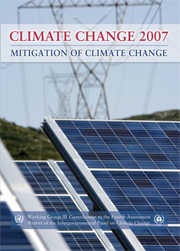 Climate Change 2007 - Mitigation of Climate Change
Climate Change 2007 - Mitigation of Climate Change Book contents
- Frontmatter
- Contents
- Foreword
- Preface
- Summary for Policymakers
- Technical Summary
- 1 Introduction
- 2 Framing issues
- 3 Issues related to mitigation in the long term context
- 4 Energy supply
- 5 Transport and its infrastructure
- 6 Residential and commercial buildings
- 7 Industry
- 8 Agriculture
- 9 Forestry
- 10 Waste management
- 11 Mitigation from a cross sectoral perspective
- 12 Sustainable Development and mitigation
- 13 Policies, instruments and co-operative agreements
- Annex I Glossary
- Annex II Acronyms, abbreviations and chemical compounds
- Annex III List of contributors
- Annex IV List of reviewers
- Index
5 - Transport and its infrastructure
- Frontmatter
- Contents
- Foreword
- Preface
- Summary for Policymakers
- Technical Summary
- 1 Introduction
- 2 Framing issues
- 3 Issues related to mitigation in the long term context
- 4 Energy supply
- 5 Transport and its infrastructure
- 6 Residential and commercial buildings
- 7 Industry
- 8 Agriculture
- 9 Forestry
- 10 Waste management
- 11 Mitigation from a cross sectoral perspective
- 12 Sustainable Development and mitigation
- 13 Policies, instruments and co-operative agreements
- Annex I Glossary
- Annex II Acronyms, abbreviations and chemical compounds
- Annex III List of contributors
- Annex IV List of reviewers
- Index
Summary
EXECUTIVE SUMMARY
Transport activity, a key component of economic development and human welfare, is increasing around the world as economies grow. For most policymakers, the most pressing problems associated with this increasing transport activity are traffic fatalities and injuries, congestion, air pollution and petroleum dependence. These problems are especially acute in the most rapidly growing economies of the developing world. Mitigating greenhouse gas (GHG) emissions can take its place among these other transport priorities by emphasizing synergies and co-benefits (high agreement, much evidence).
Transport predominantly relies on a single fossil resource, petroleum that supplies 95% of the total energy used by world transport. In 2004, transport was responsible for 23% of world energy-related GHG emissions with about three quarters coming from road vehicles. Over the past decade, transport's GHG emissions have increased at a faster rate than any other energy using sector (high agreement, much evidence).
Transport activity will continue to increase in the future as economic growth fuels transport demand and the availability of transport drives development, by facilitating specialization and trade. The majority of the world's population still does not have access to personal vehicles and many do not have access to any form of motorized transport. However, this situation is rapidly changing.
Freight transport has been growing even more rapidly than passenger transport and is expected to continue to do so in the future. Urban freight movements are predominantly by truck, while international freight is dominated by ocean shipping. The modal distribution of intercity freight varies greatly across regions.
- Type
- Chapter
- Information
- Climate Change 2007 - Mitigation of Climate ChangeWorking Group III contribution to the Fourth Assessment Report of the IPCC, pp. 323 - 386Publisher: Cambridge University PressPrint publication year: 2007
- 5
- Cited by
